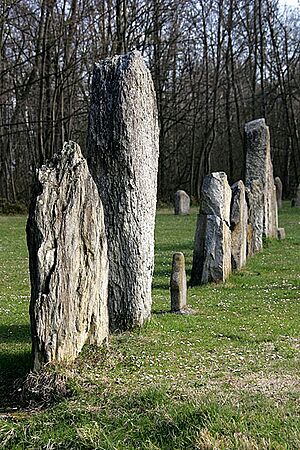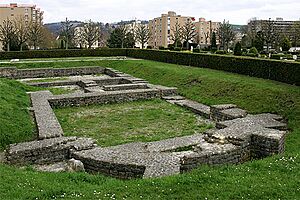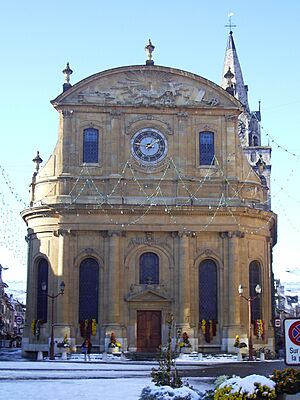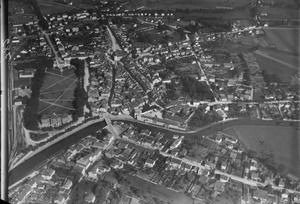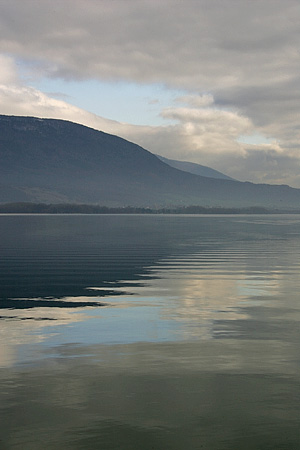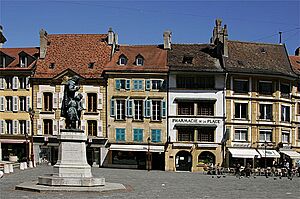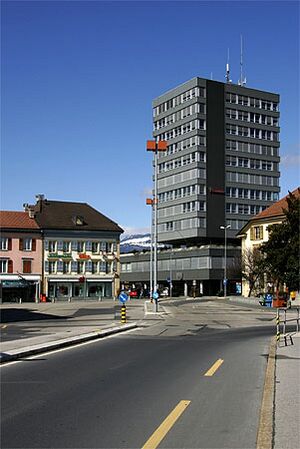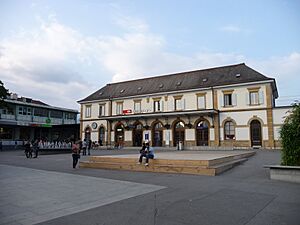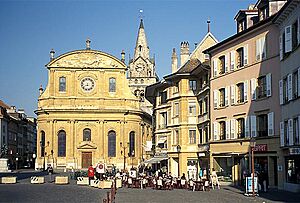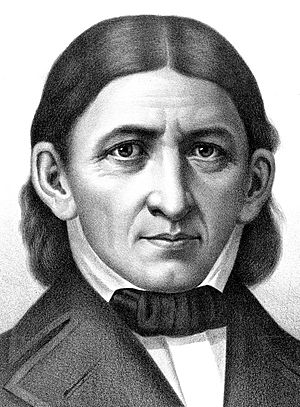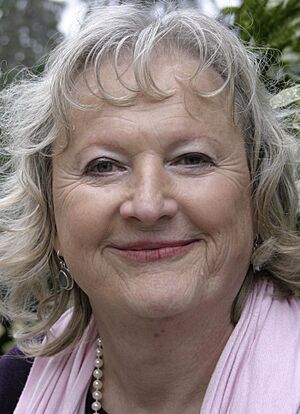Yverdon-les-Bains facts for kids
Quick facts for kids
Yverdon-les-Bains
|
||
|---|---|---|
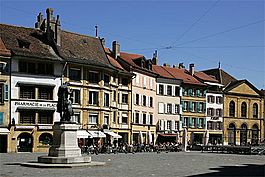
Yverdon-les-Bains
|
||
|
||
| Country | Switzerland | |
| Canton | Vaud | |
| District | Jura-Nord Vaudois | |
| Area | ||
| • Total | 13.54 km2 (5.23 sq mi) | |
| Elevation | 435 m (1,427 ft) | |
| Population
(Dec 2020 )
|
||
| • Total | 29,955 | |
| • Density | 2,212.3/km2 (5,729.9/sq mi) | |
| Postal code |
1400
|
|
| Surrounded by | Belmont-sur-Yverdon, Cheseaux-Noréaz, Cuarny, Épendes, Grandson, Gressy, Montagny-près-Yverdon, Pomy, Treycovagnes | |
| Twin towns | Nogent-sur-Marne (France), Winterthur (Switzerland), Prokuplje (Serbia), Kagamino (Japan), Pontarlier (France), Collesano (Italy) | |
Yverdon-les-Bains is a city in the canton of Vaud in Switzerland. It's located in the Jura-Nord Vaudois area. The city is known for its thermal springs, which are natural warm water sources. It's also an important center for shopping and tourism in the region.
In 2009, Yverdon-les-Bains won the Wakker Prize. This award recognized how well the city managed its public spaces. It also praised how the city connected its old town with Lake Neuchâtel.
Contents
A Look Back in Time
People have lived near Yverdon for a very long time. Archeologists have found proof that people settled here around 5000 BCE. At first, it was a small market where land and river routes met. People built temporary huts for fishing and trading. Later, they built permanent homes.
The Celtic group called the Helvetii were likely the first permanent settlers. They lived in the area, which they called Eburodunum, starting around 200 BCE.
About 100 years later, the Romans realized how important this place was. It controlled major trade routes connecting big rivers like the Rhône and Rhine.
The Strong Roman Fort
The Romans built a huge fort here called Castrum Ebredunense. It was the second largest fort in Switzerland. This shows how important Yverdon was to them. The port was a naval base for boats that supplied defenses along the Rhine River. This river was the Roman Empire's northeastern border.
The Roman town of Eburodunum grew into a busy city. People already used the sulfur springs for a thermal spa. It's even possible that the Helvetii people knew about the good effects of these waters.
Around 325 CE, after the first attacks from the Alemanni people, the Romans built a large military fort. It was about 5 acres in size. Huge walls and 15 stone towers protected it.
In the 5th century, the Barbarians attacked Italy. Roman troops from the North Alps were called back to defend Rome. The Roman soldiers and leaders had to leave the Yverdon camp. The people of Eburodunum, who lived outside the walls, quickly moved into the fort for safety. This helped Eburodunum-Yverdon survive tough times until the 15th century.
The Savoy Family's Influence
As the lake waters moved back, the old town inside the Roman fort lost its good location. It no longer had direct access to the port or new trade routes.
Peter II of Savoy slowly took control of the Vaud region. He started charging fees for roads, ports, and fishing. He then founded the new town of Yverdon. It had walls and a castle for defense. Building started around 1259, and many people moved there.
Yverdon Castle: A Historic Landmark
The castle's strong main walls and four towers were built quickly. The design was made by Jacques de Saint-Georges, a young architect. He also designed other famous castles.
Yverdon's castle was home to the leaders of the Savoy family until 1536. After that, leaders from Bern state lived there. In 1798, the castle became property of the "Helvetian Republic," which was set up by Napoleon I.
A few years later, Yverdon bought the castle. They gave it to Johann Heinrich Pestalozzi for his school. After 1838, the castle became a public school. New classrooms were added, changing the castle's look.
After 1950, these classrooms were slowly left empty. The last classes moved out in 1974. The castle was then restored to its original medieval design. Today, the castle is a cultural center. It has a museum, a theater, meeting rooms, and the oldest public library in French-speaking Switzerland. The library started in 1763.
The Bernese Era (1536–1798)
The Savoy rulers gave many freedoms to the people of Yverdon. The town did well for 200 years before the Burgundy wars.
Then, Bern took control. During nearly 300 years of Bernese rule, the economy continued to grow.
The 18th century was a great time for Yverdon. It became known as a spa town and a center for new ideas. The Yverdon Encyclopedia was published here between 1770 and 1780. The town was connected to important thinkers of the time.
The Town Hall
The town hall was built between 1768 and 1773. It stands where an old market used to be. Inside, you can see old furniture, decorated faience stoves, and paintings. The old granary vaults are now used for art shows.
The Temple
This Protestant church was built in 1757. It stands on the site of a 14th-century chapel. Its tall spire was rebuilt in 1608. Large, carved stones from the Roman fort ruins were used to build it.
Inside, there are 14 stalls showing apostles and prophets. These came from the old chapel. An organ was built in 1766.
Thermal Springs: Healing Waters
The mineral baths from the springs have been used since Roman times, and probably even before that. People believe the springs were a sacred place.
Documents from the Middle Ages show that a spa center existed as early as 1429. It had several useful buildings.
In 1728, a new spa was built, and it quickly became famous. The 18th century was a time of great success for the town and the spa. But then, the spa became less popular. By 1800, it was just a meeting place. The buildings fell apart.
In 1897, the local council decided to rebuild the spa and renovate its hotel. This was encouraged by a Spanish scientist. However, the First World War (1914–1918) caused fewer guests to visit. Still, the spa kept its good reputation until the 1930s.
Another period of decline followed. By 1960, the spa was so run down that it had to close. The idea of balneology (the study of baths and their healing effects) had also changed. The city bought the spa again.
After two failed attempts, the spa was finally rebuilt in 1974. It reopened in 1977. New thermal springs were found in 1982, and a new outdoor pool was added a year later. Today, the spa welcomes over 1,200 visitors every day.
In 2014, there was a leak of 4,000 liters of hydrochloric acid from a tank at the thermal center. No one was hurt, and people in the pools were asked to leave.
Champ-Pittet Manor House
This 18th-century manor house was once the summer home of Frédéric Haldimand. He was the first Governor of Canada (1777–1786) when it became part of the British crown.
This country estate now belongs to Pro Natura. This is a Swiss group that protects nature. It's one of their two nature centres. They hold special exhibits, shows, and guided tours of the nature reserve called the Grande Caricaie.
Geography and Landscape
Yverdon-les-Bains covers an area of about 11.3 square kilometers (4.4 square miles). About 31.6% of this land is used for farming. Forests cover 6.3% of the area. Most of the land, 57.8%, is built up with buildings or roads. Rivers and lakes make up 2.7%, and 1.8% is unproductive land.
The city was the capital of the Yverdon District until 2006. Then, it became part of the new Jura-Nord Vaudois district.
In 2011, the nearby town of Gressy merged with Yverdon-les-Bains.
City Symbols
The city's coat of arms has a green background. It shows two wavy silver lines. At the top, there is a gold letter "Y" on a silver background.
People and Languages
Yverdon-les-Bains has a population of about 28,377 people. About 34.2% of the people living here are foreign nationals. Over the last 10 years, the population has grown by about 15.2%.
Most people in Yverdon-les-Bains speak French as their first language (82.6%). Other common languages include Serbo-Croatian (3.9%) and Portuguese (3.5%). Some people also speak German or Italian.
The city has a mix of age groups. About 10.6% of the population are children aged 0-9. Teenagers aged 10-19 make up 11.4%. Adults aged 20-59 make up about 55.5% of the population. Senior citizens aged 60 and older make up about 22.6%.
Economy and Jobs
In 2010, the unemployment rate in Yverdon-les-Bains was 8.2%. The city has many different types of jobs.
- Primary sector: This includes jobs like farming and forestry. About 179 people work in this area.
- Secondary sector: This includes jobs in manufacturing and construction. About 2,219 people work here.
- Tertiary sector: This includes jobs in services like sales, transport, hotels, education, and healthcare. About 10,323 people work in this sector.
Many people travel into Yverdon-les-Bains for work. About 16.7% of workers use public transportation, and 53.9% use a private car.
Getting Around
Yverdon-les-Bains has three railway stations: Yverdon-les-Bains, Yverdon-Champ Pittet, and Yverdon William Barbey. The main station, Yverdon-les-Bains, is a busy hub. It connects to major cities like Lausanne, St. Gallen, Geneva Airport, and Zürich Hauptbahnhof. About 16,800 passengers use this station on a typical weekday.
Religion
Based on a 2000 census:
- About 35.4% of people belonged to the Swiss Reformed Church.
- About 30.7% were Roman Catholic.
- Other Christian churches, including Orthodox, made up about 5.7%.
- About 6.69% of the population were Muslim.
- A small number of people were Jewish, Buddhist, or Hindu.
- About 12.56% of the population said they had no religion or were agnostic or atheist.
Weather
Yverdon-les-Bains usually has about 118 days of rain or snow each year. It gets about 893 millimeters (35 inches) of precipitation annually. June is the wettest month, with about 92 millimeters (3.6 inches) of rain or snow over 11.2 days. April is the driest month, with about 59 millimeters (2.3 inches) over 9.4 days.
Education and Learning
Yverdon-les-Bains is a university town. It's home to the School of Business and Engineering Vaud. This public university has over 2,000 students.
Many people in Yverdon-les-Bains have a good education. About 31.6% of the population have finished high school. About 9.6% have completed higher education, like university.
In the 2009/2010 school year, there were over 3,000 students in the Yverdon-les-Bains school district. The canton (state) provides two years of optional pre-school. Primary school lasts four years, and lower secondary school lasts six years.
Yverdon-les-Bains has several museums:
- The Maison d'Ailleurs (House of Elsewhere) is a unique museum about science fiction and amazing journeys. It's the only one of its kind in Europe.
- The Musée d'Yverdon et région (Museum of Yverdon and Region) tells the story of the area.
- The Musée suisse de la Mode (Swiss Fashion Museum) focuses on fashion.
The city also has two libraries. In 2008, they had over 99,000 books and other media.
Sports
Yverdon-Sport FC is the city's main football (soccer) club.
Important Historic Sites
Nine sites in Yverdon are listed as important Swiss heritage sites. These include:
- The Public Library of Yverdon-Les-Bains.
- Yverdon Castle and its museum.
- The City Hall.
- The old L'ancien hôtel de l'Aigle.
- The Thorens House.
- The Villa d'Entremont.
- The Temple (a church).
- Clendy, a prehistoric site with stone rows.
- Eburodunum, which includes a Celtic settlement, a Roman town, and a medieval village.
Notable Buildings and Locations
- The "Menhir-Statues" and stone rows at Clendy, which are very old (from about 3000 BC).
- The Castrum, which are the remains of huge Roman walls and towers.
- The thermal springs.
- The 13th-century castle.
- The "Temple," an 18th-century Protestant church.
- The Grande Caricaie, a nature reserve along Lake Neuchâtel.
- The Maison d'Ailleurs (House of Elsewhere), a museum about science fiction.
- The Benno Besson Theatre, the oldest theater in Yverdon, built in 1898.
World Heritage Site
The prehistoric settlement at Baie de Clendy is part of the Prehistoric Pile dwellings around the Alps. This is a UNESCO World Heritage Site, recognized for its global importance.
Famous People from Yverdon
Many interesting people have connections to Yverdon-les-Bains:
- Jean-Jacques Rousseau (1712–1778), a famous philosopher and writer.
- Sir Frederick Haldimand (1718–1791), a military officer who became the first Governor of Canada.
- Johann Heinrich Pestalozzi (1746–1827), a well-known teacher and educational reformer.
- Friedrich Fröbel (1782–1852), a German teacher who studied with Pestalozzi.
- Robert Piguet (1898–1953), a fashion designer who trained Christian Dior.
- Benno Besson (1922–2006), a famous actor and director.
- Christa Muth (born 1949), a German scientist and professor.
Sister Cities
Yverdon-les-Bains is twinned with several cities around the world. This means they have special friendly relationships and often share cultural exchanges.
|
Images for kids
-
Clendy, a littoral settlement and prehistoric megalithic site
-
Eburodunum, a Celtic oppidum, a Roman vicus and a medieval and modern village
See also
 In Spanish: Yverdon-les-Bains para niños
In Spanish: Yverdon-les-Bains para niños





